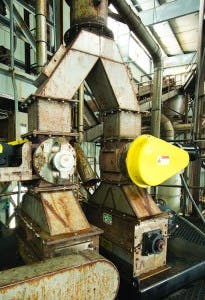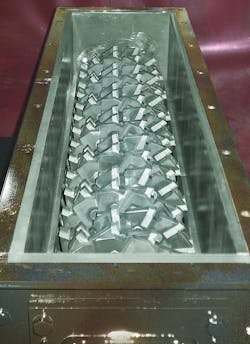Demand for calcium chloride (CaCl2) has grown with the surge in North American oil and natural gas production. That’s because, as a two-part chloride salt, its use has benefits for drilling shale formations, flushing mud from oil field holes or filling casings when drilling ends.
As oil field demand grew, Cal-Chlor Corp. became CaCl2’s largest distributor worldwide, says Brett Davis, operations director of the company’s Opelousas, Louisiana, plant.
The plant downsizes CaCl2 pellets into a powder of uniformly sized particles using five screen classifying cutters from Munson Machinery Co. Each cutter processes up to 26,000 pounds of product per hour, says Davis. To meet oil field on-time demand, the plant runs four classifying cutters and keeps the fifth for emergency use, if another goes offline. As a result, the plant’s daily CaCl2 powder production ranges from 200 to 400 tons.
Automation starts at railcars
Each screen classifying cutter reduces calcium chloride pellets into powder comprised of uniformly sized particles at rates to 26,000 pounds per hour.
The CaCl2 used in the Opelousas plant is sourced from Michigan. The salt is refined from natural brines in underground sandstone formations, and then manufactured and shipped as pellets about 0.2 inches in diameter to the Opelousas plant, and another of the company’s plants, in Ludington, Michigan.
At the Opelousas plant, loading, conveying and feeding CaCl2 is automated, so no worker handles it prior to bagging, loading and shipping. The railcars are diverted to a spur, where they park over a pit that contains a loader and conveying mechanism. The raw CaCl2 empties into the loader through the bottom of the railcar and is conveyed to a surge hopper in the plant. The hopper meters CaCl2 pellets to the four classifying cutters through an intake chute at the top of each unit.
Davis says it is important to maintain a constant feed rate. If material backs up, it will strain the cutter bearings, causing them to overheat and possibly fail. To assure an even flow, a mechanical flow control valve was installed with a variable frequency drive above each cutter.
Cutters resist ‘nasty’ effects
Davis points out that the classifying cutters are "near bulletproof" when it comes to processing CaCl2. This toughness is needed because CaCl2 is abrasive, generates heat when collected in large volume and attracts moisture. Davis calls it generally a "nasty product" that "does strange things to whatever equipment it comes in contact with." He notes that as little as 3 to 4 ounces in a cup with water will become too hot to hold in minutes. In fact, CaCl2’s heat-generating and hygroscopic properties help with snow melt and de-icing treatments for sidewalks and driveways.
The Opelousas plant operates SCC-30 models, which have a 30-inch long by 11-inch wide feed throat. The power range is 20 to 40 horsepower, and the plant operates them between 1,200 and 1,800 revolutions per minute.
The screen classifying cutter features a helical rotor design to provide maximum throughput with minimal fines and heat generation.
The units feature a helical rotor design with dozens of cutter tips. The tips are attached to a helical array of staggered holders, called interconnected parallelograms, to continuously shear oversized materials against twin stationary bed knives. The tips are also aligned along the entire shaft, ensuring total contact with the product. The tips’ helical pattern eliminates dead spots and hot spots by moving material throughout the length of the rotor. The movement takes full advantage of the screen area for maximum throughput with minimal fines and little or no heat generation, while ensuring uniform wear. The cutters are typically made of stainless steel, which resists abrasion, corrosion and other problems that CaCl2 presents.
The Ludington, Michigan, plant also operates a sixth classifying cutter model with a 48-by-11-inch feed throat to fill oil field demand for CaCl2 powder in the Rockies, New York and Pennsylvania.
Process ends with bagging
Exiting the classifying cutters, powdered CaCl2 is gravity discharged onto a conveyor and automatically transported to another surge hopper that feeds a bagging station. At this point workers fill the 50-lb. plastic valve bags with powder, palletize the bags and load them on trucks for shipping. Davis says valve bags are used because CaCl2 is too oily to effectively seal with conventional plastic bags.
As demand for CaCl2 grew, so did Opelousas’ use of the cutting technology. When Davis joined the company in 2006, the plant had two cutters, but given their effective use, the additional units were added.
Steve Knauth is the marketing manager for Munson Machinery Co. Inc. For more information about Munson, call 315-797-0090 or email [email protected].


